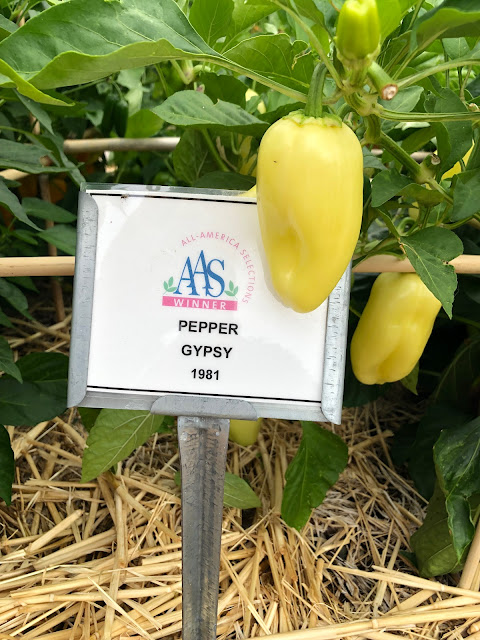
Hot August days and nights will stress gardens and gardeners

|
|
Harvest peppers to keep the plants producing. These Gypsy
peppers grow at the Fair Oaks Horticulture Center. Notice the
thick straw mulch that conserves soil moisture. (Photo:
Kathy Morrison)
|
The heat is back on! According to the National Weather Service, expect a string of triple-digit days, perhaps starting as soon as Sunday.
After a warm weekend, Sacramento’s forecast calls for 100 degrees-plus every day through at least Friday, peaking at 104 degrees on Tuesday. Overnight lows are warm, too, staying above 67 degrees.
Average for this week of August in Sacramento: High of 94 and low of 61.
Such heat is sure to stress plants -- and gardeners, too.
The good news? As hot as it will feel, we shouldn’t be flirting with any records. The hottest August day in Sacramento history: 112 degrees (set Aug. 16, 2020).
Get your chores done before 10 a.m. while the morning is still relatively cool. Water early and deeply. Remember to stay hydrated, too.
* Harvest tomatoes, beans, squash, pepper and eggplants to prompt plants to keep producing. Give your plants a deep watering twice a week, more if planted in containers.
* Squash and cucumbers refusing to set fruit? Help the pollinators, who tend not to come out in hot weather. Take a small paint brush, dip it into the center of a flower, twist slightly to gather pollen, then dip that pollen-covered brush into other flowers on the plant.
* Watch out for caterpillars and hornworms in the vegetable garden. They can strip a plant bare in one day. Pick them off plants by hand in early morning or late afternoon.
* Mulch can be your garden's best friend; it conserves moisture while blocking out weeds. But don't let mulch mound around stalks, stems or trunks. That can promote rot.
* Pinch off dead flowers from perennials and annuals to lengthen their summer bloom.
* Deadhead roses. They’ll be back in bloom in six weeks.
* Pick up after your fruit trees. Clean up debris and dropped fruit; this cuts down on insects and prevents the spread of brown rot.
* Indoors, start seedlings for fall vegetable planting, including bunching onion, cabbage, broccoli, cauliflower, kale, radicchio and lettuce.
* Sow seeds of perennials in pots for fall planting including yarrow, coneflower and salvia.
* In the garden, direct seed beets, carrots, leaf lettuce and turnips.
* Plant potatoes.
Comments
0 comments have been posted.Sacramento Digs Gardening to your inbox.
Sites We Like
Garden Checklist for week of May 5
Survey your garden after the May 4 rainstorm. Heavy rain and gusty winds can break the neck of large flowers such as roses. Also:
* Keep an eye on new transplants or seedlings; they could take a pounding from the rain.
* Watch out for powdery mildew. Warmth following moist conditions can cause this fungal disease to “bloom,” too. If you see a leaf that looks like it’s dusted with powdered sugar, snip it off.
* After the storm, start setting out tomato transplants, but wait on the peppers and eggplants (they want warmer nights). Pinch off any flowers on new transplants to make them concentrate on establishing roots instead of setting premature fruit.
* Trim dead flowers but not leaves from spring-flowering bulbs such as daffodils and tulips. Those leaves gather energy to create next year's flowers. Also, give the bulbs a fertilizer boost after bloom.
* Pinch chrysanthemums back to 12 inches for fall flowers. Cut old stems to the ground.
* Mulch around plants to conserve moisture and control weeds.
* From seed, plant beans, beets, cantaloupes, carrots, corn, cucumbers, melons, pumpkins, radishes and squash.
* Plant onion sets.
* In the flower garden, plant seeds for asters, cosmos, celosia, marigolds, salvia, sunflowers and zinnias. Transplant petunias, zinnias, geraniums and other summer bloomers.
* Plant perennials and dahlia tubers for summer bloom.
* Don’t wait; plant summer bulbs, such as gladiolus and tuberous begonias.
* Harvest cabbage, lettuce, peas and green onions.